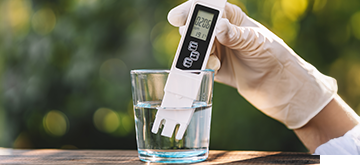
A Comprehensive Guide On How To Calculate TDS Level In The Water
PUBLISHED ON: 23-May-2025
Water quality plays a vital role in maintaining health and well-being. One of the key indicators of water quality is the Total Dissolved Solids (TDS) level, which measures the concentration of dissolved substances in water, including minerals, salts, and organic matter. Monitoring TDS levels is essential to determine whether water is safe for consumption and to choose the right water purification methods.
In this comprehensive guide, we will learn how to check water purity by calculating TDS levels and how water purification systems help maintain optimal water quality.
Why is TDS Measurement Important?
Measuring TDS levels helps to:
- Evaluate Water Purity: High TDS levels can indicate contamination that requires treatment.
- Ensure Better Taste: Balanced TDS contributes to sweet-tasting, odour-free water.
- Protect Health and Appliances: Elevated TDS can lead to health risks and scaling in kettles, pipes, water heaters, and other appliances.
- Select the Right Purifier: Knowing your water’s TDS range helps you choose the right purification method: RO, UV, or UF.
How to Calculate TDS Level in Water?
Using a Digital TDS Meter (Most Accurate Method)
A digital TDS meter is a compact, easy-to-use device that estimates TDS based on the electrical conductivity of water.
Steps to Use a TDS Meter:
1. Turn on the device and dip the sensor into your water sample.
2. Ensure the probe is submerged and not touching the container walls.
3. Wait a few seconds until the reading stabilises.
4. Note the TDS value displayed in ppm (parts per million) or mg/L.
Using Manual Calculation via Conductivity
In some cases, conductivity meters are used, especially in labs. Since TDS is roughly proportional to conductivity, it can be estimated using:
TDS (ppm) = 0.64 X EC (μS/cm) = 640 X EC (dS/m)
However, for household use, digital TDS meters remain the most reliable and practical.
Ideal TDS Range and What It Means
While TDS levels help assess water quality, understanding what each range truly means is important for making the right decisions.
• Water with TDS below 50 ppm may lack essential minerals like calcium and magnesium, leading to a flat taste and poor hydration value.
• On the other hand, TDS levels between 150–300 ppm are generally considered ideal, offering a balance between purity and palatability. This range retains beneficial minerals while avoiding harmful contaminants.
• Levels above 500 ppm might indicate the presence of excess salts, heavy metals, or industrial pollutants, requiring advanced purification such as RO.
How Do Water Purifiers Help Manage TDS Levels?
Once you've measured your water’s TDS, selecting the right purification method is key:
- RO (Reverse Osmosis): Best for TDS > 300 ppm. Removes excess salts, metals, and dissolved solids.
- UV (Ultraviolet): Ideal for low TDS water. Kills bacteria and viruses without removing minerals.
- UF (Ultrafiltration): Suitable for low TDS with physical impurities. Removes particles without affecting dissolved minerals.
Conclusion
Knowing how to check water purity by calculating TDS levels is essential for maintaining safe and clean drinking water. Whether using a TDS meter or another method, regular monitoring helps ensure water safety.
For effective purification of water, choosing the right Aquaguard water purifier is key. RO purifiers reduce high TDS, while UV and UF systems maintain the purity of low TDS water. If you’re unsure how to use the Aquaguard water purifier, follow the user manual and seek professional advice when needed. By keeping track of TDS levels and using an appropriate purification system, you can enjoy safe, healthy, and sweet-tasting water every day.
Frequently Asked Questions
Can I drink RO water with 20 ppm TDS?
Yes, but it may taste flat and lack essential minerals. Water with TDS below 50 ppm is often too demineralised for regular consumption. You may consider using a purifier with a mineraliser or TDS controller.
How often should I check TDS in my home water?
It’s recommended to check TDS every 3 to 6 months, or more frequently if you notice changes in taste, odour, or water source.
Do all water purifiers reduce TDS?
No. Only RO purifiers are designed to reduce TDS significantly. UV and UF purifiers are meant to disinfect or filter water, but they do not lower dissolved solids.
